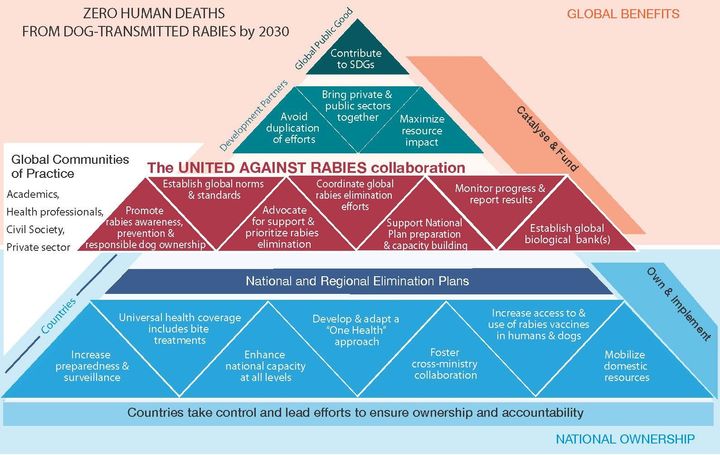Earlier this month a colleague in Karachi, Pakistan emailed me, with an account of her latest experience caring for a rabies patient, this time a 12 year old boy called Umar:
Lying on the stretcher was this handsome looking boy, alert and observant; his face was flushed and he was breathing with difficulty. Interns, nurses and doctors in training were around him.
“Are you thirsty? Would you like to drink some water?“
“I have not had food or water for two days now. I can’t swallow. But I can try.”
A nurse brought him water in a cup. Umar accepted the cup, hesitated, then attempted to drink. Immediately he began to choke, and the water regurgitated through his mouth. “Please, please, no more. Doctor, I am frightened, please help me get better. I haven’t slept and I don’t know what will happen to me”. His eyes were wide with fear and he took deep, heavy and fast breaths.
I stroked his forehead and said all would be well, just close your eyes and relax. My heart could take it no more. The young nurses lowered their moist eyes, while some simply walked away to hide their tears. I composed myself and spoke to the uncle about the futility of further treatment. We could only give him terminal comfort care with heavy sedation so that he would suffer no more. His father dead, his mother would be left just with her eight-year-old son. The uncle was prepared for the worst. That night Umar was dead.
Umar’s life was ended by a rabid dog that appeared out of nowhere whilst he was playing in the park. This happens all too often.
At the end of 2015, the international rabies community had the audacity to hope for a better future. At a global conference in Geneva, they first set a deadline of an end to human rabies from dogs by 2030. For a disease that has been around for millennia, and currently still kills tens of thousands of people a year across Africa and Asia, this is an incredibly ambitious deadline.
However, today on World Rabies Day, comes the announcement of the biggest ever global anti-rabies initiative. The United Against Rabies initiative is a collaboration between the World Health Organization (WHO), the World Organisation for Animal Health (OIE), the Food and Agriculture Organization of the UN (FAO) and the Global Alliance for Rabies Control (GARC), which today launches a strategic plan to reach ‘Zero by 30’.

The United Against Rabies collaboration will catalyse the development of country owned elimination plans to deliver on rabies elimination, a global public good
The strategic plan backs up the goal set at the global meeting with a solid foundation for action. It takes the tools and knowledge that have been proven to eliminate rabies and uses a One Health approach to address the disease in a holistic and cross-sectoral manner. At its heart is catalytic action to build community awareness of rabies prevention, and the veterinary and human health capacity that will enable rabies endemic countries to create and deliver rabies elimination strategies to protect their communities.
United Against Rabies will support this catalytic process with improved and coordinated guidance, tools, infrastructure and training, better global disease reporting systems, access to vaccines, and clear monitoring of progress. They will also advocate for further support toward the global goal from development partners.
What makes these organizations and so many others across the rabies community throw their collective commitment behind a goal of 2030? Well, it reflects the ambitious timeline of the sustainable development goals, which address the poverty, inequality and lack of access to healthcare that allow neglected diseases such as rabies to continue to kill. But what really gives the global rabies community hope that there could be an end to this horrific disease within such a short time scale, is the recent progress.

Participants at the Global Rabies Conference in Geneva, December 2015
Latin America is set to finally eliminate the public health threat of canine rabies in the next 5 years. Which leaves Africa and Asia, with over 95% of the global burden of human rabies deaths. We now know that governments there can enact rabies control programs that bring these deaths down to zero.
Pilot programmes have been completed, in the Philippines, Sri Lanka, South Africa, Tanzania, Thailand, Bangladesh and others. These small scale programs provide the invaluable proof and the confidence that the disease can be beaten. What we need now is to scale up efforts to benefit all communities still enduring canine rabies.
This last part of the puzzle is really the key reason for hope. Over the last decade, expertise from across the international rabies community has been channeled into networks, tools and mechanisms designed to scale up our means to support countries as they move towards rabies elimination. Guidelines, best practices, hard won expertise and lessons learned have been repackaged into accessible interactive tools that rabies program managers can use to design a program that will work in their settings.

A participant at a Pan African Rabies Control Network meeting accesses rabies control support tools
More tools and support mechanisms are planned, but the foundation is developed enough to move countries forward more quickly than ever before.
As the rabies control community comes together to raise awareness and to celebrate progress on World Rabies Day, it’s time to look forward to an end to the problem, and for each of us to plan our contribution to “Zero by 30”.

#Zeroby30 #WorldRabiesDay #EndRabiesNow
With thanks to Dr Naseem Salahuddin, Head of the Dept. of Medicine and Infectious Disease, The Indus Hospital, Karachi, Pakistan, for permission to reproduce her words here.
This article is part of HuffPost’s Project Zero campaign, a yearlong series on neglected tropical diseases and efforts to fight them. This series is supported, in part, by funding from the Bill & Melinda Gates Foundation. All content is editorially independent, with no influence or input from the foundation. If you’d like to contribute a post to the series, send an email to ProjectZero@huffingtonpost.com. And follow the conversation on social media by using the hashtag #ProjectZero.
